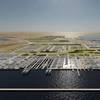Rolls-Royce has revealed a radical overhaul of its vessel design philosophy which aims to optimise construction and operations without reducing the use of space on board.
In the process it will ensure that a Rolls-Royce designed vessel, whether it is an offshore support vessel or an expedition cruise ship, is instantly recognisable world-wide. The new design incorporates four key features in each design. These are a knuckle line that slopes down towards the bow and links the new designs with older UT and NVC designs. A vertical side area and vertical upper stem which simplify the design and decouples the hull form from the superstructure. The vessels will also have a topside sheer line with a small convex curvature. These features will be present in all the designs in some form but can be modified depending on the ship type.
Martijn de Jongh, Rolls-Royce Chief Designer - Marine, said: “Less is often more in ship design and while the new elements have been devised to ensure every Rolls-Royce ship is built for optimum performance and functionality, they will be distinguished by their clear angles, clean shapes and faces. We have evaluated the profile of the vessels to omit any unnecessary aspects, like excessive large windage areas, for instance. They will be easier to build as well.”
Certain ship types may require more design modifications than others. Rolls-Royce naval architects will continue to have the freedom to adjust and apply design characteristics to suit each particular vessel, incorporating the four ‘must use’ elements.
A major feature of the approach is the decoupling of the hull design from the superstructure and other design elements, giving designers and naval architects significantly more flexibility. This minimises complex double curvature plating, common to many vessels, which is difficult and time-consuming to fabricate. The use of flat plate or single curvature plating will be increased, simplifying construction and reducing the time each vessel takes to build.
Depending on the vessel type and operational and construction requirements, the forward topside will be based on five distinct hull forms. This will allow the designs to be applied across a range of vessels from offshore vessels involved in subsea work in harsh environments to expedition cruise ships. All will have a canopied superstructure featuring a curved front with the bottom edge of the bridge wings and windows leaning down towards the bow to create a continuous line flowing into the bow.
A number of vessels designed in accordance with the new guidelines have been ordered and are now under construction. A UT 540 windfarm vessel due for delivery from Spain’s Gondon shipyard this October is typical of how the new family of UT vessels will look.











